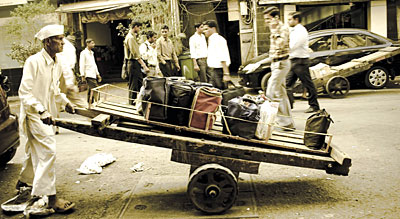 |
WASHINGTON, DC � China and India are both racing ahead economically. But the manner in which they are growing is dramatically different. Whereas China is a formidable exporter of manufactured goods, India has acquired a global reputation for exporting modern services. Indeed, India has leapfrogged over the manufacturing sector, going straight from agriculture into services.
The differences in the two countries' growth patterns are striking, and raise significant questions for development economists. Can service be as dynamic as manufacturing? Can latecomers to development take advantage of the increasing globalisation of the service sector? Can services be a driver of sustained growth, job creation, and poverty reduction?
Some facts are worth examining. The relative size of the service sector in India, given the country's state of development, is much bigger than it is in China. Despite being a low-income region, India and other South Asian countries have adopted the growth patterns of middle- to high-income countries. Their growth patterns more closely resemble those of Ireland and Israel than those of China and Malaysia.
India's growth pattern is remarkable because it contradicts a seemingly iron law of development that has held true for almost 200 years, since the start of the Industrial Revolution. According to this 'law' � which is now conventional wisdom � industrialisation is the only route to rapid economic development for developing countries.
As a result of globalisation, the pace of development can be explosive. But the potential for explosive growth has usually been seen only in the manufacturing sector. This is no longer the case. There is evidence that countries with high growth in services also tend to have high overall economic growth; conversely, countries with high overall economic growth have high services growth.
To be sure, the causal connection remains uncertain: after all, there is also a positive relationship � widely accepted in development economics � between manufacturing growth and overall growth. But what has been overlooked is that the effect of services growth on aggregate economic growth appears to be as strong, if not stronger, than the effect of manufacturing growth on overall growth.
Moreover, the trend over time to a higher service-sector share in the economy suggests that higher real growth in services has not been offset by price declines. There is no outbreak of the so-called 'Dutch disease' � that is, the price of services do not fall with an increase in the supply.
India has a higher share of services, and more rapid service-sector growth, than China, although the latter is richer and has grown faster over time. This indicates that services are not simply responding to domestic demand (which would be higher in China), but also to export opportunities.
India's growth experience suggests that a global service revolution � rapid growth and poverty reduction led by services � is now possible. In India, the service sector has not only led overall economic growth, but is also characterised by higher labour productivity than in the industrial sector. Indeed, productivity growth in India's service sector matches productivity growth in China's manufacturing sector, thereby reducing poverty by enabling wages to rise.
Service-led growth is sustainable, because globalisation of services, which account for more than 70 per cent of global output, is still in its infancy. Moreover, the long-held view that services are non-transportable, non-tradable, and non-scalable no longer holds for a host of modern impersonal services, which can now be produced and exported at low cost. Developing countries can thus sustain service-led growth, given the huge room they have for catch-up and convergence.
India's experience offers hope to other development latecomers. The process of globalisation in the late twentieth century led to a sharp divergence of incomes between those who industrialised and broke into global markets and the 'bottom billion' in some 60 countries where incomes stagnated for twenty years. It seemed as if the 'bottom billion' would have to wait their turn for development, until giant industrialisers like China became rich and uncompetitive in labour-intensive manufacturing.
The globalisation of services, however, provides alternative opportunities for developing countries to find niches, beyond manufacturing, where they can specialise, scale up, and achieve explosive growth, just like the industrialisers. As the services produced and traded across the world expand with globalisation, the possibilities for all countries to develop based on their comparative advantage expand. That comparative advantage can just as easily be in services as in manufacturing or agriculture.
The promise of the service revolution is that countries do not have to wait to get on the path to rapid development. There is a new way ahead.
Ejaz Ghani is an Economic Adviser on South Asia at the World Bank.


